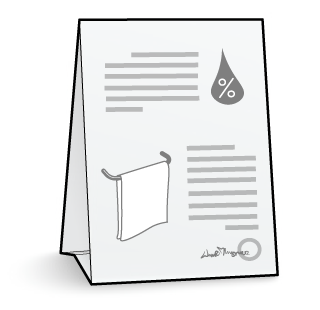Bedding and towel laundry leads to significant energy and water consumption. A typical room with 4 kg of laundry will require up to 60 litres of water. Normally beddings and towels are changed daily for a customer staying several days, however it is possible to reduce such practice to 1 to 2 times a week or at the customer's request. Such an option allows customers to limit their indirect water consumption, if they wish. Written communication is essential to this kind of practice.
When encouraged, 70% of customers adhere positively to this approach. Choose sustainable towels, beddings and mattress covers with an eco-label when replacing them or use a servicing company with an environmental approach. Linen requiring ironing demands much work and it is more favorable to opt for wrinkle-free cloth. If possible, put a laundry basket in bathrooms (preferably in a natural material) to facilitate housekeeping. Housekeeping staff training and support, such as clear written instructions (how to replace linen that should not be changed, what to do if a towel is dirty, etc.) allows for thier active participation and ensures dialogue with the staff, so their needs and expectations are met.
There are three key points for successful implementation of towel and bedclothes reuse schemes:
Cards or notices encouraging guests to reuse sheets and towels should be placed in prominent locations in the room/bathroom and inside hotel information booklets. Important information to present on such cards or notices includes:

Typically, guests are requested to indicate towel reuse by hanging towels on a towel rail in the bathroom, while sheet reuse may be indicated by not actively requesting a sheet change (Alliance for Water Efficiency, 2009).
One of the most important factors for success is the provision of adequate and easy to use towel rails for storing and drying towels between reuse (Alliance for Water Efficiency, 2009). These should be sized to accommodate towels once-folded, and positioned within easy reach of guests (average waist to shoulder height, where space allows).
Towel and bedclothes reuse schemes are only as effective as the housekeeping staff implementing them. It is essential that the staff are trained to follow the established procedures, so that if a guest hangs a towel on the rail for reuse it is not replaced by a fresh one. Good record keeping is essential, and daily checklists for each room should include changing dates for bedclothes.
Finally, guests are more likely to participate in reuse schemes when they believe it is motivated by environmental protection and not cost saving by the hotel. Referring to water, chemical and energy savings helps, but the best schemes invest laundry cost savings into environmental programmes – and convey this clearly to guests.
Environmental benefits
The environmental benefit of laundry reuse programmes will lead to water and energy savings, as well as reduced chemical use.
Reduced costs
Laundry volumes per room vary according to bed size, towel size, textile density, and number of items provided per room – often in relation to accommodation rating.
Example:
For a room with 75 % occupancy and 4 kg of laundry per room night open year around, and at a laundry service cost of EUR 0.50 per kg, annual laundry costs would equate to EUR 479. Thus laundry costs for a 100-room hotel could be EUR 47 900 per year, and a textile reuse rate of just 5 % could save almost EUR 2 400 per year.
Video
The use of this video on this site has been granted by The Travel Foundation.
Country/Location: България
Hotellityyppi: Business hotel
Small steps make the change
Näkymä